
Catocala is a generally Holarctic genus of moths in the family Erebidae. The genus was erected by Franz von Paula Schrank in 1802. The moths are commonly known as underwing moths or simply underwings. These terms are sometimes used for a few related moths, but usually – especially when used in plural, not as part of a species name – they are used to refer to Catocala only.

Catocala fulminea, the yellow bands underwing, is a moth of the family Erebidae. The species was first described by Giovanni Antonio Scopoli in his 1763 Entomologia Carniolica. It is found in central and southern Europe, east Asia and Siberia. The xarippe lineage has been proposed to be a distinct and valid species in its own right, instead of being only subspecifically distinct.

Catocala meskei, or Meske's underwing, is a moth of the family Erebidae. The species was first described by Augustus Radcliffe Grote in 1873. It is found in North America from Maine and Quebec west to southern Alberta and Montana, south to South Carolina in the east and at least Montana in the west.

Catocala whitneyi, or Whitney's underwing, is a moth of the family Erebidae. The species was first described by G. M. Dodge in 1874. It is found in North America from North Dakota, Nebraska, and Kansas eastward through Wisconsin to Ohio and Tennessee. It has also been recorded as far west as Minnesota and Utah. In Canada, it has been found in Manitoba.
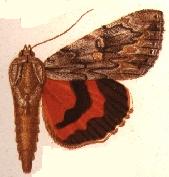
Catocala coccinata, the scarlet underwing, is a moth of the family Erebidae. The species was first described by Augustus Radcliffe Grote in 1872. It is found in southern Canada and the eastern United States, following river valleys onto the Great Plains and down to Florida.

Catocala junctura, the joined underwing or Stretch's underwing, is a moth in the family Erebidae. The species was first described by Francis Walker in 1858. It is found throughout temperate North America, ranging from New York and Pennsylvania west to Montana, Colorado, Oklahoma, Arizona, and into Texas, and north to southern Illinois, extreme southern Alberta and Saskatchewan; it has also been recorded west of the Rocky Mountains from California and south-eastern British Columbia. It is typically found near water, where the food plants of its caterpillar larvae grow plentifully.
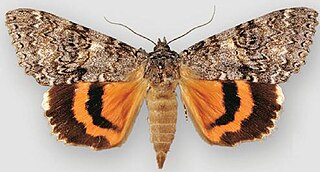
Catocala unijuga, the once-married underwing, is a moth of the family Erebidae. The species was first described by Francis Walker in 1858. It is found in North America from Newfoundland west to south central British Columbia, south to Kentucky and Missouri in the east, Colorado and Utah in the west.
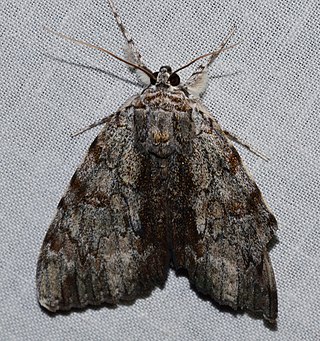
Catocala insolabilis, the inconsolable underwing, is a moth of the family Erebidae. The species was first described by Achille Guenée in 1852. It is found in North America from Ontario through Maine and Connecticut south to Florida, west through Arkansas to Texas and Oklahoma and north to South Dakota.

Catocala judith, or Judith's underwing, is a moth of the family Erebidae. The species was first described by Strecker in 1874. It is found in North America from southern Quebec and Ontario to the United States from New Hampshire south through Connecticut and New Jersey to North Carolina and Georgia, west to Oklahoma and Iowa and north to Wisconsin.

Catocala innubens, the betrothed underwing, is a moth of the family Erebidae. The species was first described by Achille Guenée in 1852. It is found in North America from southern Ontario and Quebec south through Michigan, Connecticut, Tennessee to Florida and west to Texas and Oklahoma and north to Wisconsin.

Catocala pretiosa, the precious underwing, is a moth of the family Erebidae. The species was first described by Joseph Albert Lintner in 1876. It was included in Catocala crataegi by many authors, but recently it has been revalidated as a distinct species. The subspecies of pretiosa is listed as a species of special concern and believed extirpated in the US state of Connecticut.
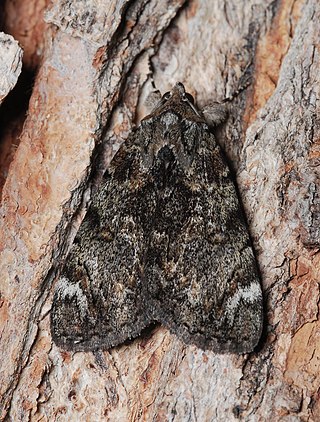
Catocala minuta, the little underwing, is a moth of the family Erebidae. The species was first described by William Henry Edwards in 1864. It is found in the US from New York to Florida and west to Texas and north to South Dakota, Indiana and Michigan.

Catocala grynea, the woody underwing, is a moth of the family Erebidae. The species was first described by Pieter Cramer in 1780. It is found in North America from Ontario and Quebec through Maine and Connecticut, south to Florida, west to Texas and north through Iowa to Wisconsin and Minnesota.
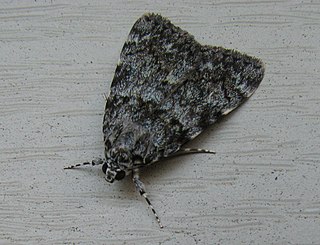
Catocala lineella, the lineella underwing, little lined underwing or steely underwing, is a moth of the family Erebidae. The species was first described by Augustus Radcliffe Grote in 1872. It is found in North America from Ontario and Quebec south to Florida west to Texas and north to Ohio.

Catocala messalina, the Messalina underwing, is a moth of the family Erebidae. The species was first described by Achille Guenée in 1852. It is found in the United States from Virginia south to Florida and west to Texas and north to Kansas.

Catocala miranda, the Miranda underwing, is a moth of the family Erebidae. The species was first described by Henry Edwards in 1881. It is found in the US from Illinois, Pennsylvania and Massachusetts to Florida and west to western North Carolina.
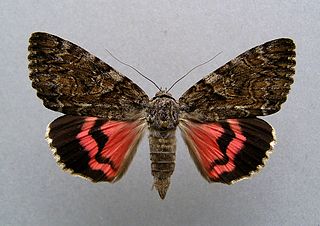
Catocala dilecta is a moth of the family Erebidae first described by Jacob Hübner in 1808. It is found in north-western Africa through southern Europe to Asia Minor.

Catocala lupina is a moth in the family Erebidae first described by Gottlieb August Wilhelm Herrich-Schäffer in 1851. It is found from south-eastern Europe to south-western Siberia, Asia Minor and Transcaucasia.

Catocala oberthueri is a species of moth in the family Erebidae first described by Jules Léon Austaut in 1879. It is found in Spain, Tunisia, Algeria and Morocco.

William David Barnes was an American entomologist and surgeon. He was the son of William A. and Eleanor Sawyer Barnes. He graduated from the Decatur High School in 1877. Then spent a year at Illinois State University followed by a year at University of Illinois at Urbana–Champaign. In 1879, he entered Harvard Medical School and graduated in 1886. While at Harvard, he met naturalist Louis Agassiz and his love of Lepidoptera grew. Agassiz taught him how to preserve and classify the butterflies. He completed an internship at Boston City Hospital and then studied abroad in Heidelberg, Munich, and Vienna. In 1890, Dr. Barnes came home to Decatur and opened his medical practice. That same year he married Charlotte L. Gillette. The couple had two children.
















